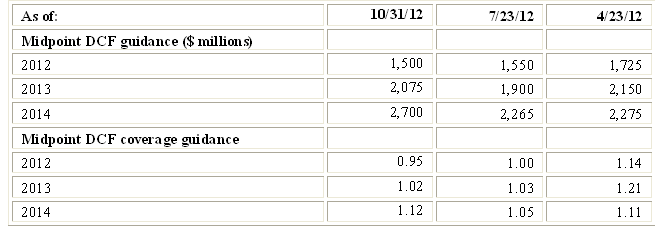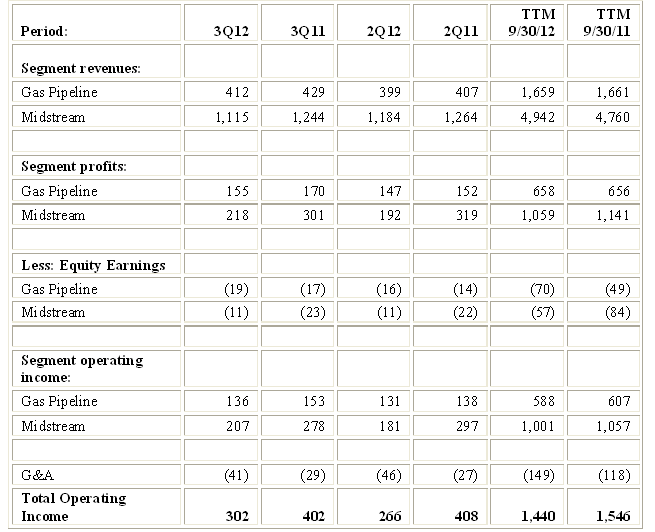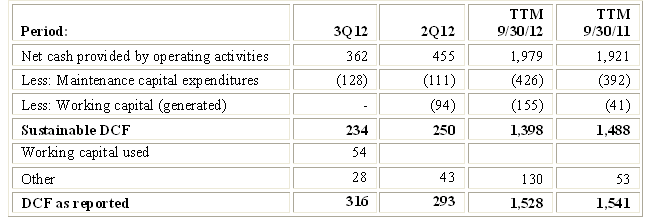On October 31, 2012 July 23, 2012, Williams Partners, L.P. (WPZ) announced results for 3Q12 that did not meet expectations and were sharply lower than 3Q11. It lowered Distributable Cash Flow (“DCF”) guidance for 2012 but increased it for 2013-2014.
On October 31, 2012, WPZ also disclosed the price ($2.36 billion) of the previously announced agreement to a acquire an 83.3% interest in the Geismar Olefins-Production Facility from Williams Companies, Inc. (WMB) and that it would issue WMB 42.8 million units to pay for this acquisition (i.e., virtually an all equity deal). WMB is WPZ’s general partner and owns a ~64% limited partner interest, a 2% general partner interest and incentive distribution rights (“IDRs”). Following the Geismar acquisition WMB’s limited partner interest would increase to ~68% (~70% including the general partner interest).
Located south of Baton Rouge, Louisiana, the Geismar facility is a light-end NGL cracker with current volumes of 39,000 barrels per day (bpd) of ethane and 3,000 bpd of propane and annual production of 1.35 billion pounds of ethylene. With the benefit of an expansion under way and scheduled for completion by late 2013, the facility’s annual ethylene production capacity will grow by 600 million pounds to 1.95 billion pounds. Since the owner of the remaining ownership interest in the facility is not participating in the expansion, WPZ’s overall undivided interest following the expansion will be ~ 88%. The Geismar acquisition is expected to bring more certainty to cash flows that are currently exposed to volatile ethane prices by shifting the commodity price exposure to ethylene. The transaction reduces WPZ’s ethane exposure by 70% in 2013 and fully eliminates it by 2014 (when WPZ will effectively be short ethane).
The downward revision to 2012 DCF guidance follows another, much larger, downward revision announced on July 23, 2012. The recent upward revision to 2013-2014 DCF guidance includes the positive effect of the Geismar drop-down ($240 million in 2013 and $570 million in 2014), offset by lower expected overall gathering volume growth rates and other factors. WPZ’s DCF guidance following publication of its 1Q12, 2Q12 and 3Q 12 results is detailed in Table 1 below:
The weak results announced 3Q12, as well as in 2Q12, primarily reflect a sharp decline in prices for natural gas liquids (“NGL”). WPZ’s Midstream segment provides natural gas gathering and processing services under fee contracts (volumetric-based), keep-whole agreements and percent-of-liquids arrangements. Under keep-whole and percent-of-liquid processing contracts (see glossary of terms), the Midstream segment retains the rights to all or a portion of the NGLs extracted from the producers’ natural gas stream and recognizes revenues when the extracted NGLs are sold and delivered; hence lower NGL prices mean lower revenues, as well as lower segment profits and operating income, as seen in Table 2 below (“TTM” = trailing twelve months): 
Table 2 clearly shows the performance deterioration with respect to 2Q12, 3Q12 and also, to a lesser extent, the TTM period ending 9/30/12. It is likely that 2012 will compare very unfavorably with 2011 results. This holds true not just for revenues and operating income, but also for DCF.
The definition of DCF used by WPZ is described in an article titled Distributable Cash Flow. That article also provides, for comparison purposes, definitions used by other master limited partnerships. Using WPZ’s definition, DCF for the TTM period ending 9/30/12 was $1,528 million ($4.79 per unit), down from $1,541 million ($5.35 per unit) in the TTM period ending 9/30/11.
The generic reasons why DCF as reported by the MLP may differ from sustainable DCF are reviewed in an article titled Estimating Sustainable DCF-Why and How. Due to the significant deterioration of performance in the past two quarters, I apply the method described there to recent quarterly data, not only to the TTM periods, even though I find quarterly comparisons to be less meaningful. Reported and sustainable DCF numbers for WPZ are outlined in Table 3 below: 
The gaps between reported DCF and sustainable DCF in Table 3 relate mostly to “other” and are comprised principally of adjustments for earnings from unconsolidated subsidiaries and certain acquisition-related adjustments (e.g., management added back to DCF $26 million of Caiman-related transaction costs in 2Q12). But overall, the TTM differences between reported and sustainable DCF are not huge. In deriving 3Q12 reported DCF, management added back $54 million of cash consumed by working capital. I generally do not add back working capital used, but do deduct working capital generated, from net cash from operations in deriving sustainable DCF. Despite appearing to be inconsistent, this makes sense because in order to meet my definition of sustainability the MLP should generate enough capital to cover normal working capital needs. On the other hand, cash generated by the MLP through the liquidation or reduction of working capital is not a sustainable source and I therefore ignore it. Over reasonably lengthy measurement periods, working capital generated tends to be offset by needs to invest in working capital. I therefore do not add working capital used to net cash provided by operating activities in deriving sustainable DCF.
Coverage ratios are indicated in Table 4 below: 
The sharply lower coverage ratios reflect the decline in NGL prices and, to a lesser extent, higher G&A expenses (as shown in Table 2). While I did not anticipate the decline in NGL prices, I did mention in a prior article (dated May 24, 2012) the risk of lower coverage ratios resulting from the rapid growth in the number of units outstanding as a result of issuing equity to partially finance large acquisitions. Indeed, this has been a major contributing factor as can be seen in Table 4. The Geismar acquisition closed on November 5, 2012. This further increases the number of units outstanding by ~42.8 million.
It is helpful to look at a simplified cash flow statement by netting certain items (e.g., acquisitions against dispositions) and by separating cash generation from cash consumption. Here is what I see for WPZ:
Simplified Sources and Uses of Funds 
Net cash from operations, less maintenance capital expenditures, less cash related to net income attributable to non-partners exceeded distributions by $213 million in the TTM ending 9/30/12 and by $449 million in the comparable prior year period. But it fell short of covering distributions in both 2Q12 ($18 million shortfall) and 3Q12 ($139 million shortfall). This is of great concern and is highly unusual for WPZ (did not occur in any of the 10 quarters prior to 2Q12). For the past 2 quarters WPZ has been financing distributions through the issuance of equity and debt. Yet it is maintaining distribution growth guidance at 8% for 2012 and 9% (midpoint) per annum for 2013-2014. DCF coverage of distribution is projected by WPZ, at the midpoint, to be 0.95, 1.02 and 1.12 for 2012, 2013 and 2014, respectively
To recap some of the major developments at WPZ this year:
The large ($2.5 billion) and expensive (12.5x 2013 cash flow or, more accurately, times segment profit plus depreciation and amortization) move into the liquids-rich Marcellus shale via the Caiman Eastern Midstream acquisition (March 2012);
Issuance of additional partnership units amounting to ~$2.6 billion through 9/30/12
Increase of ~$825 million in long-term debt;
Two quarters of poor performance with DCF coverage of ~0.83 on a reported basis and ~0.66 on a sustainable basis;
The $2.4 billion Geismar acquisition which is yet to be reflected in terms of additional units outstanding;
WMB will waive ~$16 million per quarter of IDRs until the later of Dec. 31, 2013 or 30 days after the Geismar plant expansion is operational. The foregone IDRs will last ~5 quarters and total ~$80 million. WMB also agreed to waive IDRs, through 2013, on units issued to Caiman and WMB in connection with Caiman Eastern. I estimate this will total an additional $80 million.
Not surprisingly, following price per unit has languished and is down ~12% year-to-date (from ~$60 to $52.95 as of 11/6/12). Despite the recent signs of weakness I have been adding to my WPZ position on pullbacks for the following reasons:
Low natural gas prices are incorporated into the 203-2014 guidance numbers;
While the Caiman Eastern acquisition will require ~$1.34 billion in capital expenditures from 2012-2014, management projects segment profit plus depreciation and amortization in 2014 to more than double the 2013 level and exceed $400 million;
The benefits of the Geismar facility expansion currently under way are projected to be very significant. Management estimates segment profit plus depreciation and amortization in 2014 (the first year of post-expansion operations) to total $570 million, a modest 4.4 multiple of the purchase price plus the additional $270 million of post-closing capital expenditures.
Management has, in the past, consistently run significant excess DCF coverage. Its decision to significantly dilute unitholders in executing two transformative transactions, in conjunction with an adverse NGL pricing environment, has turned the excess into a shortfall. Unit price has declined significantly and presents a buying opportunity for investors whose faith in management is intact and who are willing to wait until 2014 when results will show whether such faith was justified.
- English (UK)
- English (India)
- English (Canada)
- English (Australia)
- English (South Africa)
- English (Philippines)
- English (Nigeria)
- Deutsch
- Español (España)
- Español (México)
- Français
- Italiano
- Nederlands
- Português (Portugal)
- Polski
- Português (Brasil)
- Русский
- Türkçe
- العربية
- Ελληνικά
- Svenska
- Suomi
- עברית
- 日本語
- 한국어
- 简体中文
- 繁體中文
- Bahasa Indonesia
- Bahasa Melayu
- ไทย
- Tiếng Việt
- हिंदी
Closer Look At Williams Partners’ Distributable Cash Flow As Of 3Q 201
Published 11/12/2012, 03:19 AM
Updated 07/09/2023, 06:31 AM
Closer Look At Williams Partners’ Distributable Cash Flow As Of 3Q 201
3rd party Ad. Not an offer or recommendation by Investing.com. See disclosure here or
remove ads
.
Latest comments
Install Our App
Risk Disclosure: Trading in financial instruments and/or cryptocurrencies involves high risks including the risk of losing some, or all, of your investment amount, and may not be suitable for all investors. Prices of cryptocurrencies are extremely volatile and may be affected by external factors such as financial, regulatory or political events. Trading on margin increases the financial risks.
Before deciding to trade in financial instrument or cryptocurrencies you should be fully informed of the risks and costs associated with trading the financial markets, carefully consider your investment objectives, level of experience, and risk appetite, and seek professional advice where needed.
Fusion Media would like to remind you that the data contained in this website is not necessarily real-time nor accurate. The data and prices on the website are not necessarily provided by any market or exchange, but may be provided by market makers, and so prices may not be accurate and may differ from the actual price at any given market, meaning prices are indicative and not appropriate for trading purposes. Fusion Media and any provider of the data contained in this website will not accept liability for any loss or damage as a result of your trading, or your reliance on the information contained within this website.
It is prohibited to use, store, reproduce, display, modify, transmit or distribute the data contained in this website without the explicit prior written permission of Fusion Media and/or the data provider. All intellectual property rights are reserved by the providers and/or the exchange providing the data contained in this website.
Fusion Media may be compensated by the advertisers that appear on the website, based on your interaction with the advertisements or advertisers.
Before deciding to trade in financial instrument or cryptocurrencies you should be fully informed of the risks and costs associated with trading the financial markets, carefully consider your investment objectives, level of experience, and risk appetite, and seek professional advice where needed.
Fusion Media would like to remind you that the data contained in this website is not necessarily real-time nor accurate. The data and prices on the website are not necessarily provided by any market or exchange, but may be provided by market makers, and so prices may not be accurate and may differ from the actual price at any given market, meaning prices are indicative and not appropriate for trading purposes. Fusion Media and any provider of the data contained in this website will not accept liability for any loss or damage as a result of your trading, or your reliance on the information contained within this website.
It is prohibited to use, store, reproduce, display, modify, transmit or distribute the data contained in this website without the explicit prior written permission of Fusion Media and/or the data provider. All intellectual property rights are reserved by the providers and/or the exchange providing the data contained in this website.
Fusion Media may be compensated by the advertisers that appear on the website, based on your interaction with the advertisements or advertisers.
© 2007-2024 - Fusion Media Limited. All Rights Reserved.
